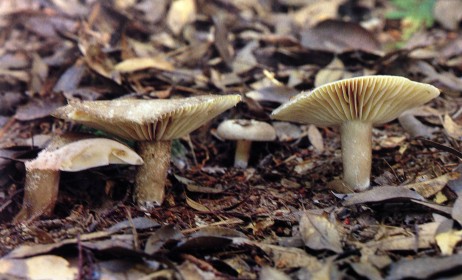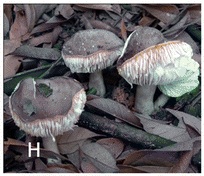A deadly Russula
An entertaining way to confirm a mushroom is a Russula is to throw it at something (a tree, the ground, a friend) and watch for its explosion into little pieces. This is satisfying because it confirms the brittle nature of the mushroom while at the same time reducing the risk that you will attempt to identify it, a process sure to end in tears. Michael Kuo (of mushroomexpert.com) feels that advanced Russula identification “is a joke” with species distinctions frequently based on subtle, arbitrary and highly variable differences.1 It’s always good to be able to identify mushrooms to avoid eating toxic species, but with Russula, so far, this is quite a challenge. Luckily most Russula species aren’t harmful beyond a stomachache, however, one of a few toxic exceptions is the deadly Russula subnigricans.
 Russula subnigricans is a mushroom first found in Japan in 1955. Since then, it has also been found in China, Taiwan and has sometimes been reported in the Southeastern US.* It is one of the blushing Russulas, but it’s not shy: once broken, its tissues slowly bruise red. Two images of this species are shown here.6,4H They don’t look very similar to me— the cap colors and gills look very different (let’s go with the first one, which appeared in a book6 coauthored by the very mycologist who first described it). This demonstrates the variability of Russulas even within a species, or perhaps differences in opinion between experts due to the difficulty of identification. Scientists aren’t the only ones struggling with Russula identification; many people have misidentified this species and eaten it. One study reports that it caused a quarter of the 852 mushroom poisonings in the past 18 years in Southern China.4 Half the people who ate it died!
Russula subnigricans is a mushroom first found in Japan in 1955. Since then, it has also been found in China, Taiwan and has sometimes been reported in the Southeastern US.* It is one of the blushing Russulas, but it’s not shy: once broken, its tissues slowly bruise red. Two images of this species are shown here.6,4H They don’t look very similar to me— the cap colors and gills look very different (let’s go with the first one, which appeared in a book6 coauthored by the very mycologist who first described it). This demonstrates the variability of Russulas even within a species, or perhaps differences in opinion between experts due to the difficulty of identification. Scientists aren’t the only ones struggling with Russula identification; many people have misidentified this species and eaten it. One study reports that it caused a quarter of the 852 mushroom poisonings in the past 18 years in Southern China.4 Half the people who ate it died!
 The horrible thing about R. subnigricans is that it causes rhabdomyolysis, or the breakdown of muscle tissue. This is a painful process that can lead to kidney failure. Rhabdomyolysis can also be induced by physical damage to muscle tissue, or abuse of drugs like cocaine. In R. subnigricans, the toxin that causes it is cycloprop-2-ene carboxylic acid— only recently discovered in 2009.3 Earlier studies found toxins dubbed russuphelins, but it was later questioned whether the researchers had identified their toxic mushroom correctly (darn you Russulas!).4 The reason it has taken so long to identify the real toxin is that it’s unstable, making its isolation and detection difficult; it is also not directly toxic to cells, further complicating experiments.3 Although the exact mechanism is not understood, the toxin appears to trigger a cascade of reactions in the body, resulting in widespread breakdown of muscle. If the muscles in your heart or your diaphragm get broken down, you’re in trouble as your heart may stop, or you may stop breathing. After muscle tissue is broken down, massive amounts of one of its chemical components (myoglobin) are carried to the kidneys. In high enough doses, this causes kidney failure. In terms of toxicity, 2.5 mg/kg of dried mushroom kills mice. If humans are like mice, then two or three mushrooms can kill a person.3
The horrible thing about R. subnigricans is that it causes rhabdomyolysis, or the breakdown of muscle tissue. This is a painful process that can lead to kidney failure. Rhabdomyolysis can also be induced by physical damage to muscle tissue, or abuse of drugs like cocaine. In R. subnigricans, the toxin that causes it is cycloprop-2-ene carboxylic acid— only recently discovered in 2009.3 Earlier studies found toxins dubbed russuphelins, but it was later questioned whether the researchers had identified their toxic mushroom correctly (darn you Russulas!).4 The reason it has taken so long to identify the real toxin is that it’s unstable, making its isolation and detection difficult; it is also not directly toxic to cells, further complicating experiments.3 Although the exact mechanism is not understood, the toxin appears to trigger a cascade of reactions in the body, resulting in widespread breakdown of muscle. If the muscles in your heart or your diaphragm get broken down, you’re in trouble as your heart may stop, or you may stop breathing. After muscle tissue is broken down, massive amounts of one of its chemical components (myoglobin) are carried to the kidneys. In high enough doses, this causes kidney failure. In terms of toxicity, 2.5 mg/kg of dried mushroom kills mice. If humans are like mice, then two or three mushrooms can kill a person.3
 Symptoms usually begin 30 min to 2 hours after ingestion and include nausea, vomiting, diarrhea and abdominal pain. These are common, non-specific symptoms of mushroom poisoning. However, within 6-12 hours victims also have general muscle pain, speech impairment, convulsions, pupil contraction, stiff shoulders, backaches, trouble breathing and myoglobinuria, which turns their urine red and contributes to kidney failure. Most deaths occur 12 to 24 hours after ingestion.4
Symptoms usually begin 30 min to 2 hours after ingestion and include nausea, vomiting, diarrhea and abdominal pain. These are common, non-specific symptoms of mushroom poisoning. However, within 6-12 hours victims also have general muscle pain, speech impairment, convulsions, pupil contraction, stiff shoulders, backaches, trouble breathing and myoglobinuria, which turns their urine red and contributes to kidney failure. Most deaths occur 12 to 24 hours after ingestion.4
Treatment for rhabdomyolysis in the case of mushroom poisoning is mainly supportive— there is no specific antidote. The victim is kept hydrated and dialysis may be performed in an attempt to prevent kidney failure. The main factors dictating survival are how much mushroom was consumed and how soon after ingestion treatment begins.
A few other mushrooms are known to cause rhabdomyolysis, including Tricholoma equestre (the Man on Horseback). It is globally widespread and was a treasured “edible” mushroom— at least until scientists discovered it caused rhabdomyolysis. A 2001 study examined the 12 cases of delayed rhabdomyolysis in France from 1992-2001. This study documented victims experiencing symptoms of rhabdomyolysis 24-72 hours after the last meal of T. equestre. Of the 12 patients, 3 died. To confirm T. equestre was the culprit, the authors experimented with mushroom extract on mice and determined it was indeed the cause.5 The specific compound causing rhabdomyolysis was not determined, but this mushroom is no longer invited to dinner. Now it reminds us to be humble, as there are many things we don’t know about this species yet, and furthermore about over 90% of fungi.
These deadly mushrooms serve as a reminder to respect mushrooms and correctly identify them before eating them. Mushrooms can do some pretty crazy complicated stuff and make some weird molecules we don’t understand. Even familiar mushrooms like T. equestre that we thought were safe sometimes turn out not to be. Although we now know the toxic component of R. subnigricans, we are still only beginning to understand its effects. With this in mind, if you find a Russula, you might as well throw it at a tree and enjoy the show…
*Editor’s Note: The true identity of “Russula subnigricans” specimens found in the southeast US is up for debate–we have no reports of poisonings; they may well be a different fungus. It’s enlightening to consider this: the scientists who discovered the toxin3 had to go to great lengths to be sure they had the right mushroom to study. They compared two putative R. subnigricans collections: one from Western Japan and one from Northeastern Japan. They determined which was the true R. subnigricans by checking to see which collection was poisonous to mice.
References:
- Kuo, M. (2009, March). The genus Russula. Retrieved from the MushroomExpert.Com Web site on October 26, 2013.
- Lee Po-Tsang, Wu Ming-Ling, Tsai Wei-Jen, Ger Jiin, Deng Jou-Fang, Chung Hsiao-Min. Rhabdomyolysis: An unusual feature With mushroom poisoning. American Journal of Kidney Diseases. 2001, 38(4); E17-U71.
- Matsuura M, Saikawa Y, Inui K, Nakae K, Igarashi M et al. Identification of the toxic trigger in mushroom poisoning. Nat Chem Biol. 2009, 5: 465-467. doi:10.1038/nchembio.179.
- Chen Zuohong, Zhang Ping, Zhang Zhiguang. Investigation and analysis of 102 mushroom poisoning cases in Southern China from 1994 to 2012. Fungal Diversity. 2013. doi: 10.1007/s13225-013-0260-7
- Bedry R, Baudrimont I, Deffieux G, Creppy EE, Pomies JP, Ragnaud JM, Dupon M, Neau D, Gabinski C, De Witte S, Chapalain JC, Godeau P, Beylot J. Wild-mushroom intoxication as a cause of rhabdomyolysis. The New England Journal of Medicine. 2001, 345(11), 798-802.
- Image of R. subnigricans from: Rokuya Imazeki, Yoshio Otani, and Tsuguo Hongo, (with photos by Masana Izawa and Nakahiko Mizuno). Fungi of Japan (Nihon no Kinoko). 1988. Yama-Kei Publishers, Japan. [ISBN-13: 9784635090209] One of the authors of this book, T. Hongo, was the first to give our fungus a name.7
- Tsuguo Hongo. Notes on Japanese larger Fungi (6). Journal of Japanese Botany 1955. 30(3) 73-79. [in which our mushroom was first named]


another post confirming that mycologists and their amateur foraging kin are not only witty but well-informed.
a great blog.